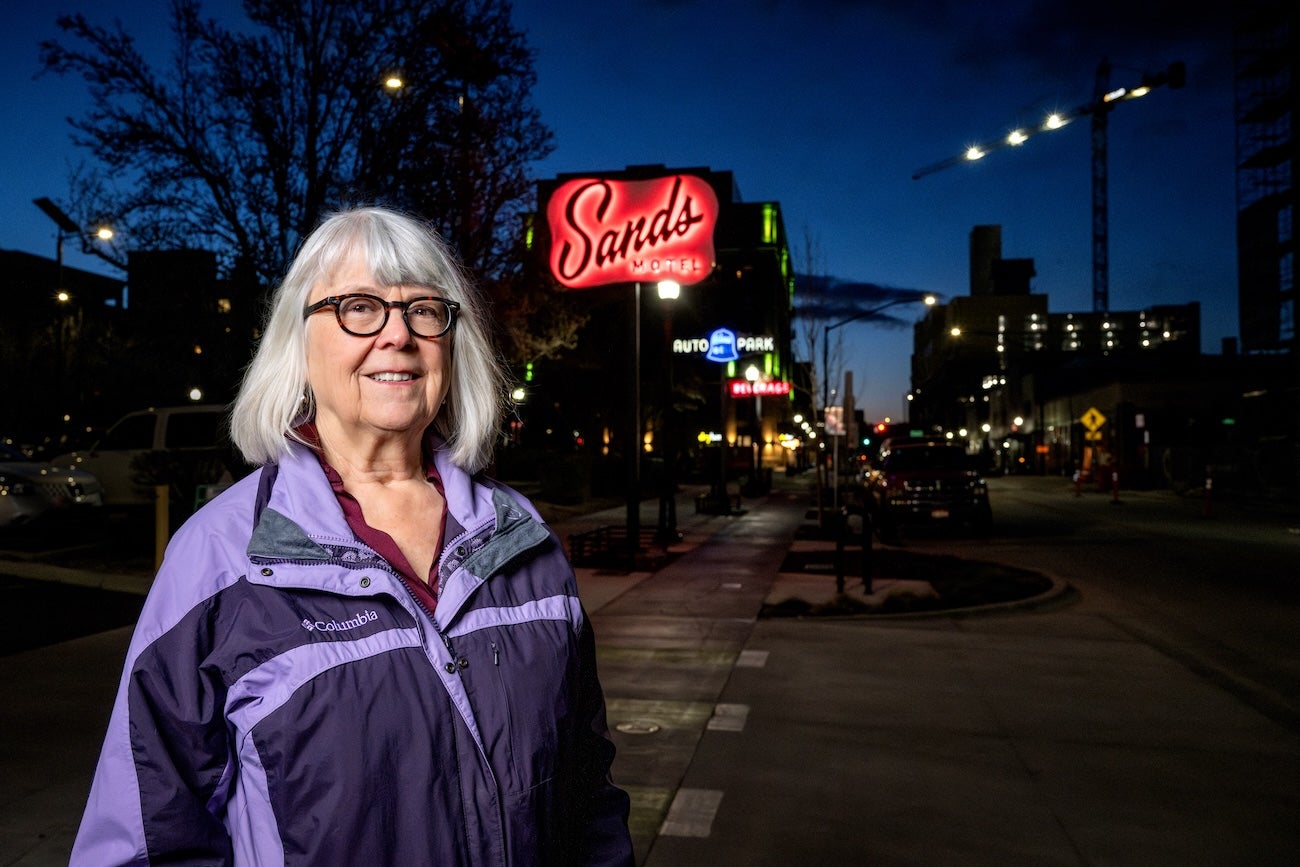
Thanks to Boise State alum Vangie Osborn (BBA, economics, 1974), Boise has its first outdoor, historic neon sign gallery, the Neon Grove. Six restored signs that once marked thriving Boise businesses now dot Grove Street between 12th and 13th Streets in the city’s Linen District. The signs are sleek. They gleam with mid-century (and earlier) hipness in tones of blue, pink and red. That vintage sparkle belies Osborn’s hard work and persistence.
Osborn’s neon journey began two decades ago when she worked for the Idaho Shakespeare Festival. She was organizing an event in an empty downtown building when she came upon the Royal Optical sign – long-time Boiseans will remember the sign, shaped like a pair of 1950s-style cat-eye glasses on Idaho Street – and another sign shaped like a coffee cup from the Quickie Cafe, which once operated on 8th Street. When Osborn remarked on the signs, the building’s property manager told her she could have them. She took him up on his offer. She began finding more historic signs without homes and soon founded her aptly named nonprofit, Signs of Our Times. Since that first discovery, Osborn has collected 45 signs, 11 of them neon.
“Neon signs are really lovely,” Osborn said. “In their heyday, craftspeople made them with true design in mind, to attract people. Artisans knew how to do that through style and color and good lettering.” The Neon Grove signs, all from buildings that no longer stand, create nostalgia for a lost era, Osborn said. “And they get people talking.”
An evolving neighborhood
Through the years, Osborn has found partners, donors and other lovers of classic advertising to support her efforts. Boise’s Capital City Development Corporation, which paid for the restoration and installation of the Neon Grove, embraced the signs as a “key feature” of its revitalization plans for the Linen District, said Amy Fimbel, the agency’s senior project manager for capital improvements.
Historically dominated by surface parking lots and few pedestrian attractions, the block of Grove Street between 12th and 13th streets “is being transformed into a destination,” Fimbel said. The six signs are reminders of what the quickly transforming Linen District once was – a commercial, transitory place. Two signs, the Sands Motel and Chuck Dragoo Auto Sales, glow near their original locations.
Boise State alum Amber Beierle (BA, history, 2004, MA, public/applied history, 2007), former historic sites administrator at the Idaho State Historical Society and current executive director of The Boise Farmers Market, prepared a history of the signs for the Capital City Development Corporation. Beierle believes that Osborn’s work to save Boise signs cuts to the heart of the city itself.
“Vangie is unifying people through history,” Beierle said. “What was Boise? Where is Boise going? What’s better than a large neon sign to help people begin to ask these questions?” The signs mean something to native Boiseans, Beierle added, but also to newcomers eager to connect to the city.
Bright past, bright future

The Boise City Department of Arts & History will manage the Neon Grove.
“We’re grateful to Vangie with Signs of Our Times, Capital City Development Corporation, and the dedicated restoration professionals behind this first-of-a-kind project,” said Jennifer Stevens, director. “These signs celebrate Grove Street’s rich car-centric history from the post-war era. We hope Boiseans and visitors alike explore this open-air gallery and discover or rediscover an aspect of this area’s rich past.”
Osborn credits Yanke Machine Shop with storing her signs and YESCO, Classic Design Studio and Rocket Neon for their expert restoration.
From storage to spotlight?
As for what comes next, Osborn wants all of her signs to eventually see the light of day – and the glow of night. She still has the cat-eye glasses and coffee cup, the pieces that began it all, in storage. Her collection includes signs from the late, great Mel Day’s Fiesta Ballroom (once in the Eagle Building at 6th and Idaho Streets) and The Interlude (a lost, classic Boise bar on 8th Street, north of Main Street). She also has the Hotel Boise neon that crowned what’s now known as the Hoff Building at 8th and Bannock. The original sign was three stories tall. The “B” alone stands over 11 feet. “I hope to find a home for all of them,” Osborn said.
One sign in the collection has a more immediate destination. The owner of the Smith Block on Main Street (now under renovation) was interested in the Cub Tavern sign that adorned what became Bar Gernika on the Basque Block. He called Osborn to find out more about the sign, hoping to have a similar one made. Osborn did him one better. Signs of Our Times is leasing him the fully restored original.